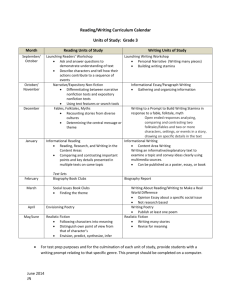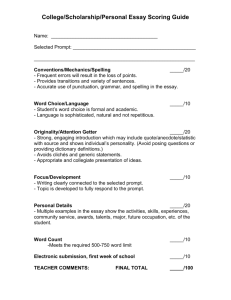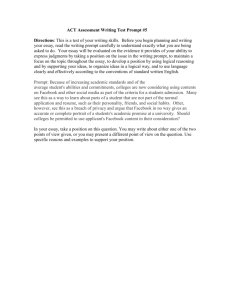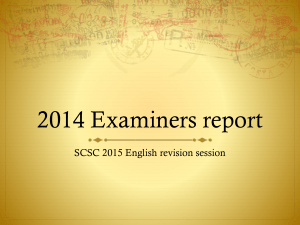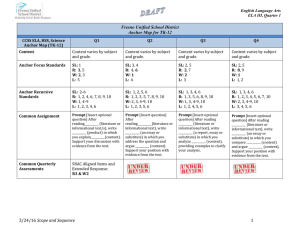Scope and Sequence ENG III Quarter 3
advertisement
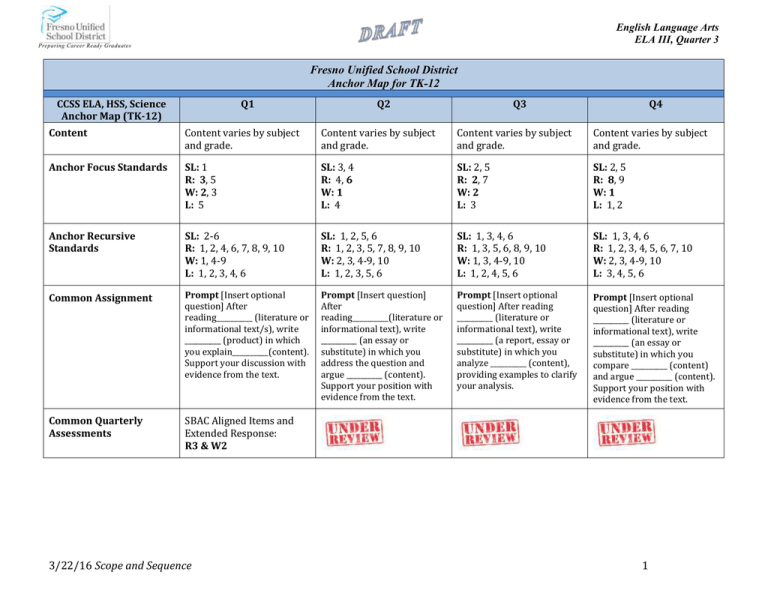
English Language Arts ELA III, Quarter 3 Preparing Career Ready Graduates Fresno Unified School District Anchor Map for TK-12 CCSS ELA, HSS, Science Anchor Map (TK-12) Q1 Q2 Q3 Q4 Content Content varies by subject and grade. Content varies by subject and grade. Content varies by subject and grade. Content varies by subject and grade. Anchor Focus Standards SL: 1 R: 3, 5 W: 2, 3 L: 5 SL: 3, 4 R: 4, 6 W: 1 L: 4 SL: 2, 5 R: 2, 7 W: 2 L: 3 SL: 2, 5 R: 8, 9 W: 1 L: 1, 2 Anchor Recursive Standards SL: 2-6 R: 1, 2, 4, 6, 7, 8, 9, 10 W: 1, 4-9 L: 1, 2, 3, 4, 6 SL: 1, 2, 5, 6 R: 1, 2, 3, 5, 7, 8, 9, 10 W: 2, 3, 4-9, 10 L: 1, 2, 3, 5, 6 SL: 1, 3, 4, 6 R: 1, 3, 5, 6, 8, 9, 10 W: 1, 3, 4-9, 10 L: 1, 2, 4, 5, 6 SL: 1, 3, 4, 6 R: 1, 2, 3, 4, 5, 6, 7, 10 W: 2, 3, 4-9, 10 L: 3, 4, 5, 6 Common Assignment Prompt [Insert optional question] After reading__________ (literature or informational text/s), write __________ (product) in which you explain__________(content). Support your discussion with evidence from the text. Prompt [Insert question] After reading__________(literature or informational text), write __________ (an essay or substitute) in which you address the question and argue __________ (content). Support your position with evidence from the text. Prompt [Insert optional question] After reading __________ (literature or informational text), write __________ (a report, essay or substitute) in which you analyze __________ (content), providing examples to clarify your analysis. Prompt [Insert optional question] After reading __________ (literature or informational text), write __________ (an essay or substitute) in which you compare __________ (content) and argue __________ (content). Support your position with evidence from the text. Common Quarterly Assessments SBAC Aligned Items and Extended Response: R3 & W2 3/22/16 Scope and Sequence 1 English Language Arts ELA III, Quarter 3 Preparing Career Ready Graduates Quarter 3, Grades 6-12 Content Map ELA History/Social Studies Science Content Inquiry and Communication CA H/SS Content Standards through the C3 Inquiry Arc Framework CA Science Standards and Next Generation Science Standards Focus Standards SL: 2, 5 RL & RI: 2, 7 W: 2 L: 3 SL: 2, 5 RHSS: 2, 7 WHSS: 2 SL: 2, 5 RST: 2, 7 WST: 2 SL: 1, 3, 4, 6 RL & RI: 1, 3, 5, 6, 8, 9, 10 W: 1, 3-10 L: 1, 2, 4, 5, 6 SL: 1, 3, 4, 6 RHSS: 1, 3, 5, 6, 8, 9, 10 WHSS: 1, 3-10 L: 1-6 SL: 1, 3, 4, 6 RST: 1, 3, 5, 6, 8, 9, 10 WST: 1, 3-10 L: 1-6 Prompt [Insert optional question] After reading __________ (literature or informational text), write __________ (a report, essay or substitute) in which you analyze __________ (content), providing examples to clarify your analysis. Prompt [Insert optional question] After reading __________ (literature or informational text), write __________ (a report, essay or substitute) in which you analyze __________ (content), providing examples to clarify your analysis. Prompt [Insert optional question] After reading __________ (literature or informational text), write __________ (a report, essay or substitute) in which you analyze __________ (content), providing examples to clarify your analysis. Recursive Standards Common Assignment Common Quarterly Assessment 3/22/16 Scope and Sequence 2 English Language Arts ELA III, Quarter 3 Preparing Career Ready Graduates Unit 3 Overview The Conversation Drives Content and Skill Acquisition Focus Standards RL & RI: 2, 7; W: 2; SL: 2, 5; L: 3 Recursive Standards RL & RI: 1, 3, 5, 6, 8, 9, 10; W: 1, 3-10; SL: 1, 3, 4, 6; L: 1, 2, 4, 5, 6 ELD Standards Highlight complementary ELD standards that include interacting in meaningful ways (Section 1/Part I), learning about how English works (Section 1/Part II), all using foundational literacy skills (Section 1/Part III), all grounded in texts and discourse in context (Section 2). Anchor Texts Reading & Listening to Complex Texts Suggested Related Texts At least one of the following texts will anchor the set: *Lexile Range: 1215-1355L *Three Dimensions of Text Complexity: Novels: 1984 Lexile: 1090L The quantitative Lexile level of 1090 reflects the grade band of 9-10. However, the qualitative review identifies this text as very complex due to meaning and purpose, historical knowledge demands, and language features. Based on these sets of measures, this text is appropriate for an anchor text at 11th grade. FUSD core & extended works. Catcher in the Rye Lexile: 790L The quantitative Lexile level of 790 reflects the grade band of 4-5. However, the qualitative review identifies this text as very complex due to meaning and purpose, historical knowledge demands, and language features. Based on these sets of measures, this text is appropriate for an anchor text at 11th grade. FUSD 3/22/16 Scope and Sequence Suggested literary, informational, and non-print texts to provide additional opportunities to explore the essential and supporting questions through reading, writing, and talking. In combination with the anchor text, these texts may add depth, provide a range of ideas, and provide scaffolds for learning. Additional texts should be selected with attention to the three dimensions of text complexity. Extended Texts: “Enemy of the People,” Henrik Ibsen The Prince, Machiavelli Black Boy, Richard Wright Henry V Julius Caesar Utopia, Thomas More Ordinary People, Judith Guest The Catcher in the Rye, J.D. Salinger The Red Badge of Courage, Stephen Crane To Destroy You Is No Loss, Joan Criddle The Way of the Owl Night, Elie Weisel A Tale of Two Cities, Charles Dickens “O Captain! My Captain!” Walt Whitman Anthology Selections: “Civil Disobedience” (excerpt), Thoreau “On Civil Disobedience,” Gandhi from Narrative of the Life of Frederick Douglass, an American Slave Ballad of Birmingham by Dudley Randall Stride Towards Freedom, M.L. King Jr. Necessary to Protect Ourselves, Malcolm X How it Feels to be Colored Me, Zora Neale Hurston Wandering, Lanford Wilson “The Man Who Was Almost a Man,” Richard Wright Expository Texts: Gettysburg Address Writing & Speaking to Texts Writing to Learn Routine writing: Includes short constructed responses to text-dependent questions, note-taking, brainstorming ideas, learning logs, writing-to-learn tasks, and crafting summaries in response to text. Analyses: Emphasizes the use of evidence, as well as crafting works that display logical integration and coherence. These responses can vary in length based on the questions asked and tasks performed. Analyses serve as both formative and summative assessments of students’ ability to paraphrase, infer, and ultimately integrate the ideas they have gleaned from what they have read. Narratives: Offers students opportunity to express personal ideas and experiences through stories and descriptions. Deepens their understanding of literary concepts, structures, and genres through purposeful imitation. Provides additional opportunities for students to reflect on what they read through imaginative writing and practice with sequencing events and ideas through narrative descriptions. Product types: Represent the ability to communicate through various socially constructed representational forms. Examples include: Composition: Argumentative writing, informational/explanatory writing, narrative writing, analytical writing, literary/rhetorical analysis of text, written response to text. 3 English Language Arts ELA III, Quarter 3 Preparing Career Ready Graduates core works. The Things They Carried Lexile: 880L The quantitative Lexile level of 880 reflects the grade band of 4-5. However, the qualitative review identifies this text as very complex due to meaning and purpose, historical knowledge demands, and language features. Based on these sets of measures, this text is appropriate for an anchor text at 11th grade. FUSD core works. Fahrenheit 451 Lexile: 880L The quantitative Lexile level of 890 reflects the grade band of 4-5. However, the qualitative review identifies this text as very complex due to meaning and purpose, historical knowledge demands, and language features. Based on these sets of measures, this text is appropriate for an anchor text at 11th grade. FUSD core works. Plays: Hamlet Lexile: 1390L The quantitative Lexile level of 1390 reflects the grade band of 11-CCR. It is also qualitatively complex due to meaning and purpose, historical knowledge demands, and language features. Based on these sets of measures, this text is appropriate for an anchor text at 11th grade. FUSD core works. Macbeth The quantitative Lexile level of 1350 reflects the grade band of 11-CCR. It is also qualitatively complex due to meaning and purpose, historical knowledge demands, and language features. Based on these sets of measures, this text is appropriate for an anchor text at 11th grade. FUSD core works. Lexile: 1350L Expository: 3/22/16 Scope and Sequence Why Soldiers Won’t Talk, Steinbeck Seven Habits of Highly Effective People The Most Successful Leaders do 15 Things Automatically http://www.forbes.com/sites/glennllopis/2013/02/18/the-mostsuccessful-leaders-do-15-things-automatically-every-day/ Qualities that Make a Great Leader http://www.forbes.com/sites/tanyaprive/2012/12/19/top-10qualities-that-make-a-great-leader/ The 21 Indispensable Qualities of a Leader http://www.ansc.purdue.edu/courses/communicationskills/leaderq ualities.pdf Seven Leadership Qualities of Great Leaders http://www.briantracy.com/blog/leadership-success/the-sevenleadership-qualities-of-great-leaders-strategic-planning/ Chemical Weapons Crisis: Debating the U.S. Response in Syria http://learning.blogs.nytimes.com/2013/09/10/chemical-weaponscrisis-debating-the-u-s-response-in syria/?nl=learning&emc=edit_ln_20130912&_r=0 Leadership with You: Case Study: Adolph Hitler http://www.leadership-with-you.com/adolf-hitler-leadership.html When Is the Use of Military Force Justified? http://learning.blogs.nytimes.com/2013/09/10/when-is-the-use-ofmilitary-force-justified/?nl=learning&emc=edit_ln_20130912&_r=0 Ethical Leadership http://ctb.ku.edu/en/tablecontents/sub_section_main_138.aspx Teaching Orwell and “1984” with the Times http://learning.blogs.nytimes.com/2013/02/14/teaching-orwelland-1984-with-the-times/?_r=0 Big Brother vs. Little Brother: Updating Orwell’s “1984” http://learning.blogs.nytimes.com/2010/10/21/big-brother-vslittle-brother-updating-orwells-1984/ Does the Technology of Orwell’s “1984” really exist? http://www.wired.com/gadgetlab/2008/02/does-the-techno/ Teaching Civics with the Times http://learning.blogs.nytimes.com/category/civics/ Hamlet Should be on Stage Not be in the Oval Office http://www.washingtonpost.com/blogs/rightturn/wp/2013/09/13/hamlet-should-be-on-stage-not-in-the-ovaloffice/ Discussion: Oral response to text, oral presentations of arguments/information, group discussions. Reflection: Written and oral reflections of experiences readings, writings, listening, speaking, and viewing. Suggested Range of Products: Response to literature Expository composition Analytical composition Debate Speech Essay Mock Trial Powerpoint w/accompanying essay Video Art project w/accompanying essay Non-Print Texts: 100 Greatest American Leaders 100 Greatest World Leaders 4 English Language Arts ELA III, Quarter 3 Preparing Career Ready Graduates “Self-Reliance” Lexile: 1140L The quantitative Lexile level of 1140 reflects the grade band of 9-10. However, the qualitative review identifies this text as very complex due to meaning and purpose, historical knowledge demands, and language features. Based on these sets of measures, this text is appropriate for an anchor text at 11th grade. Poetry: “At the Justice Department” The qualitative review identifies this text as very complex due to meaning and purpose, historical knowledge demands, and language features. Based on these sets of measures, this text is appropriate for an anchor text at 11th grade. Lexile: Not Available “Mending Wall” Lexile: Not Available The qualitative review identifies this text as very complex due to meaning and purpose, historical knowledge demands, and language features. Based on these sets of measures, this text is appropriate for an anchor text at 11th grade. 3/22/16 Scope and Sequence What Would you Fight For? https://www.nd.edu/fighting-for/2009/fighting-for-ethicalleadership/ Steve Jobs: How to Live Before You Die http://www.ted.com/talks/steve_jobs_how_to_live_before_you_die.ht ml “Every Kid Needs a Champion” by Rita Pierson (Ted talk philosophy) “Lost” TV show clips Ted Talks: Everyday Leadership http://www.ted.com/talks/drew_dudley_everyday_leadership.html Leadership Definition http://www.teamtechnology.co.uk/leadership-basics.html Herblock’s Political Cartoons http://www.loc.gov/rr/print/swann/herblock/ Radio Broadcast: This I Believe “Courage” http://thisibelieve.org/theme/courage/ “Responsibility” http://thisibelieve.org/theme/responsibility/ Ethics Visual http://cdn.i-sight.com/uploads/Ethics-Challenge.jpg Calisphere: Primary Sources & more http://www.calisphere.universityofcalifornia.edu/ 5 English Language Arts ELA III, Quarter 3 Preparing Career Ready Graduates The Common Assignment: Responding to the Conversation Common Assignment Prompt Frame (Insert optional question) After reading __________(literature or informational text/s), write __________(a report, an essay or substitute) in which you analyze __________(content) providing examples to clarify your analysis. 3/22/16 Scope and Sequence Sample Common Assignment Prompt After reading “Adolescence” by Rita Dove, write 2-3 paragraphs in which you analyze one theme that develops over the course of the poem providing examples from the text to clarify your analysis, using precise language and domain specific vocabulary with the techniques of metaphor and simile. 6 English Language Arts ELA III, Quarter 3 Preparing Career Ready Graduates LDC Informational/Explanatory Teaching Task Rubric *Template Task Collection Version 2.0 Scoring Elements Focus Controlling Idea Reading/ Research Development Organization Conventions Content Understanding Not Yet 1 Approaches Expectations 1.5 2 Meets Expectations 2.5 3 Advanced 3.5 4 Addresses prompt appropriately, but with a weak or uneven focus. Addresses prompt appropriately and maintains a clear, steady focus. D: Addresses additional demands sufficiently. Addresses all aspects of prompt appropriately and maintains a strongly developed focus. D: Addresses additional demands with thoroughness and makes a connection to controlling idea. Establishes a controlling idea with a general purpose. Establishes a controlling idea with a clear purpose maintained throughout the response. Establishes a strong controlling idea with a clear purpose maintained throughout the response. Presents information from reading materials relevant to the purpose of the prompt with minor lapses in accuracy or completeness. Presents information from reading materials relevant to the prompt with accuracy and sufficient detail. Accurately presents information relevant to all parts of the prompt with effective selection of sources and details from reading materials. Attempts to provide details in response to the prompt, including retelling, but lacks sufficient development or relevancy. Presents appropriate details to support the focus and controlling idea. Presents appropriate and sufficient details to support the focus and controlling idea. Presents thorough and detailed information to strongly support the focus and controlling idea. Attempts to organize ideas, but lacks control of structure. Uses an appropriate organizational structure to address the specific requirements of the prompt, with some lapses in coherence or awkward use of the organizational structure Maintains an appropriate organizational structure to address the specific requirements of the prompt. Maintains an organizational structure that intentionally and effectively enhances the presentation of information as required by the specific prompt. Attempts to demonstrate standard English conventions, but lacks cohesion and control of grammar, usage, and mechanics. Sources are used without citation. Demonstrates an uneven command of standard English conventions and cohesion. Uses language and tone with some inaccurate, inappropriate, or uneven features. Inconsistently cites sources. Demonstrates a command of standard English conventions and cohesion, with few errors. Response includes language and tone appropriate to the audience, purpose, and specific requirements of the prompt. Cites sources using an appropriate format with only minor errors. Demonstrates and maintains a well-­­ developed command of standard English conventions and cohesion, with few errors. Response includes language and tone consistently appropriate to the audience, purpose, and specific requirements of the prompt. Consistently cites sources using an appropriate format. Attempts to include disciplinary content in explanations, but understanding of content is weak; content is irrelevant, inappropriate, or inaccurate. Briefly notes disciplinary content relevant to the prompt; shows basic or uneven understanding of content; minor errors in explanation. Accurately presents disciplinary content relevant to the prompt with sufficient explanations that demonstrate understanding. Integrates relevant and accurate disciplinary content with thorough explanations that demonstrate in-­­ depth understanding. Attempts to address prompt, but lacks focus or is off-­­task. Attempts to establish a controlling idea, but lacks a clear purpose. Attempts to present information in response to the prompt, but lacks connections or relevance to the purpose of the prompt. 3/22/16 Scope and Sequence 7


